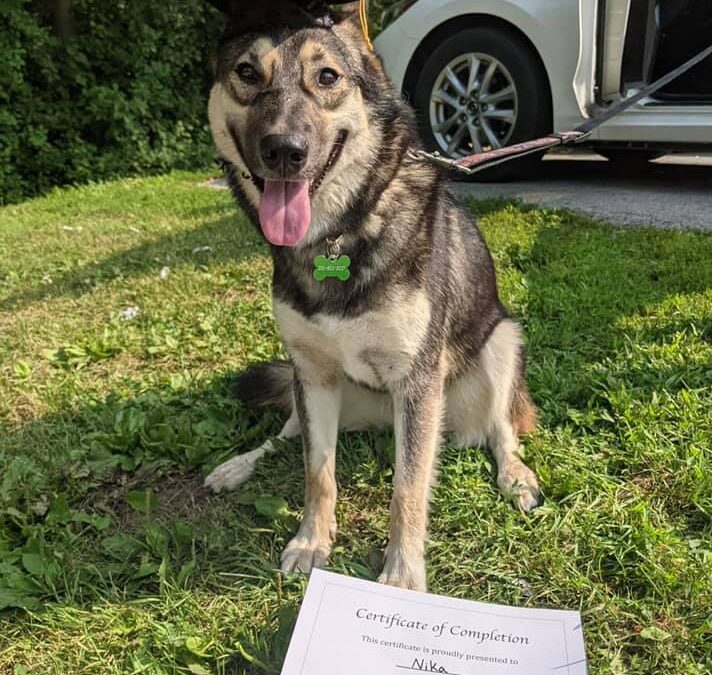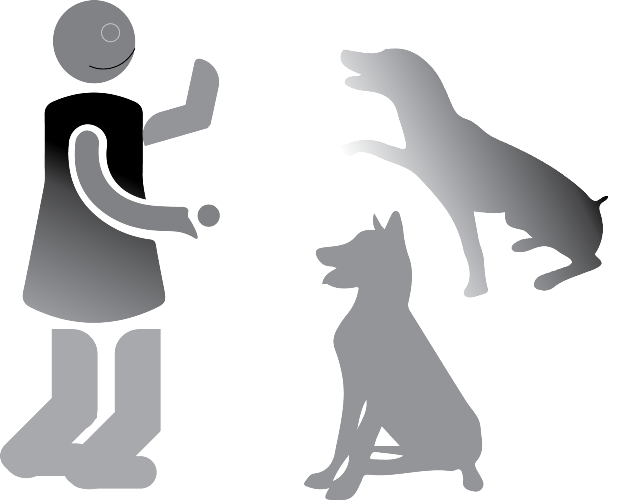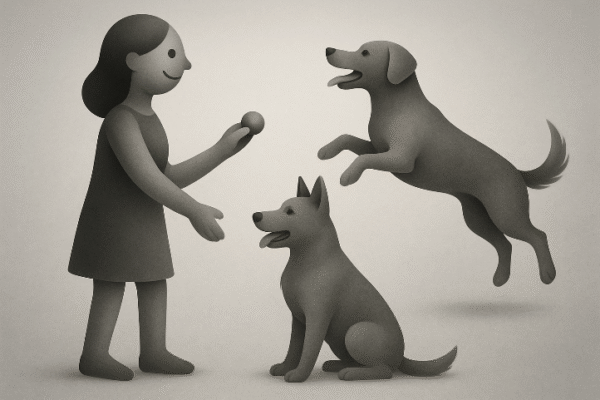
by The Crunchy Canine | Oct 19, 2021 | Dog Training, TESTIMONIALS
Nika the Husky Mix | Dog Training Brantford
We had such a positive experience working with our trainer Katie (Dog Training Brantford). Very professional, well experienced and worked around our schedule for training. NIKA really benefited from all the little tips and tricks we learned along the way and was a really great fit for our needs. Even though Covid through a curve ball at our training schedule, Katie was always so accommodating and in the end we feel confident that the training was one of the best things we could have offered Nika for a happy dog life. Thanks so much to everyone at The Crunchy Canine for creating such a positive experience!
Heather with Nika from Brantford, ON
 View on goolge map
View on goolge map
You may like to know more “Bailey the furture Service Dog“

by The Crunchy Canine | Aug 9, 2021 | BLOG
 If you have a dog, or know someone with a dog you have probably heard about the importance of socialization! As new puppy owners, the term “socialization” gets drilled into your head. You MUST socialize this puppy otherwise it will be aggressive as an adult! Rescues often put in the description of their dogs who are either leery of humans or dogs (or aggressive towards them) that the dog was undersocialized as a puppy.
If you have a dog, or know someone with a dog you have probably heard about the importance of socialization! As new puppy owners, the term “socialization” gets drilled into your head. You MUST socialize this puppy otherwise it will be aggressive as an adult! Rescues often put in the description of their dogs who are either leery of humans or dogs (or aggressive towards them) that the dog was undersocialized as a puppy.
While we totally agree that proper socialization (key here is proper, and not just letting anyone and everyone tough and pick up your puppy, and definitely not taking them to the dog park) is super important, it may not be as crucial as you think. But how can that be? Socialization is the answer to all of your dog’s problems right? Nope! In fact over socialization is certainly a thing and cause it’s own set of issues. However, what we are talking about here is the fact that “training” and/or “socialization” cannot always and often does not override genetics.
Take for example children, sending them to school and doing all the extra curricular activities…while yes we should be getting our kids out and doing things with other people, these do not guarantee that your child will be an outgoing, super social butterfly who loves all the sports and activities. I myself attended public school, participated in countless activities (competitive dance, cheerleading, swimming, horseback riding, piano, skiing and more). I however, am extremely introverted, hate public speaking, have social anxiety and would take a small group of 2-4 people over a large party any day.
In fact, the thought of going to a large social gathering often makes me physically ill. My son who is now 6 attended daycare, preschool and Junior Kindegarten, played soccer, T-ball, took swimming lessons and gymnastics. He is also very shy, takes awhile to warm up to people and situations and would prefer 1-2 kids to play with than a big group. There are also plenty of people out there who did not participate in tons of activities, and many who were homeschooled and they are very outgoing, love big groups and gatherings.
Just like people, our dogs have their own distinct personalities. They are also specific breeds, and they are a product of their ancestors and genetics. On top of that, the real socialization window is actually from 3-14 weeks, so unless you are actively working on it then, you will just be training to undo whatever lack of socialization or bad experiences they had during that window. Due to this, finding a quality breeder who knows all about the critical window of opportunity is going to also play a huge role in who your dog becomes (but again not guaranteed because of course there are backyard breeders who have friendly dogs out there as well).
So while socialization is important, and proper socialization gives your puppy the best chance at being a well rounded adult dog, it does not guarantee they will love everyone and everything! We strongly suggest that you do focus on proper socialization to give your puppy the best chance at being a well rounded, friendly adult dog, remember that it does not guarantee anything!
by The Crunchy Canine | Jul 8, 2021 | BLOG
We often find our clients not understanding why their dog struggles with certain behaviours. Most of the time the human has set a certain expectation and the dog fails miserably. Leading up to this failure no criteria was set, not enough training time was put in, and expectations were not met. So how do we dissect this and get passed it?
Take for example a dog who is reactive to other dogs while on leash. Most dog owners have no idea what the criteria should be and have high expectations of their dog. What does that mean? All they know is that they want their dog to walk politely past other dogs right? However, if we raise our criteria and lower the expectations we can make major headway in our training. So when we are working with reactive dogs we raise our criteria; you must be able to stay calm, listen to my commands, accept food, and keep moving while we train. That will most likely mean you need to move further away from the trigger.
We are in turn lowering our expectations in that I do not expect my dog to be able to do any of those things at a certain distance from the trigger, rather I figure out where I can be successful at raising my criteria. So if at 20ft your dog loses his mind when he sees another dog, cannot accept food, and does not respond to any commands then you need to lower your expectations. It is unreasonable at this time to expect him to be successful at 20ft. If at 40ft he can stay mostly calm, accept food, listen to commands and keep moving then you have raised the criteria but lowered your expectations.
As you progress in your training you will be able to continue to raise the criteria. For example the criteria is to be able to do the above listed things at a closer distance, but keeping your expectations reasonable based on the amount of training you have been doing.
Another very basic example for this would be lets say you are working on your dogs sit command. You want your dog to be able to listen to your command the first time and hold a sit in any environment. However, when out in public around people he cannot do it just yet. So, how do we raise the criteria but lower our expectations? Raise the criteria; you must sit the first time when I ask, you must hold the command until I release you, and I will enforce this no matter what.
My expectation that my dog can do this needs to be lowered as I know he struggles. So I have to think how can I set this up so my dog is successful? Train at a further distance, make sure my leash is on so I can enforce the commands, and then make it happen (no matter what). I am not expecting my dog to be perfect, but I am raising the criteria and helping him be successful. As he gets good at this we move closer while still maintaining our criteria.
So if you are struggling with your dog’s behaviour, the best thing to do is to take a step back, think about what it is you need your dog to be able to do (or not do), lower your expectations, and raise the criteria for training.
by The Crunchy Canine | May 23, 2021 | TESTIMONIALS
“We did private lessons with Katherine for a dog we adopted that had some issues. She was great to work with and very knowledgeable. We saw a lot of improvement in our dog once we started to work with Katherine. It’s been great to see the change in his confidence! Would 100% recommend!”
Christine with Marmot
by The Crunchy Canine | Oct 27, 2020 | BLOG
Leash reactivity…what is it? Does your dog have it? Is it aggression?

Fix Leash Reactivity
Let’s unpack what leash reactivity is. When a dog is on leash, and has a reaction to certain triggers/distractions. These reactions can be minor like change in posture or panting, to something more severe like lunging and barking. Luckily, for most dogs reactivity does not equal aggression (though sometimes it does).
Why does my dog have leash reactivity? There are a few different possibilities to this question. First, many overly friendly dogs who are leash reactive are excited when they see another dog. They may end up barking, jumping around, hitting the end of the leash and carrying on. Often these dogs are dogs who attend dog daycares, dog parks, or are allowed to go up and say hi to most dogs they see on a walk. While this type of dog is not aggressive it is often embarrassing for the humans and often stressful for the other dogs. Another reason your dog might be leash reactive is barrier frustration. Think of a dog who is barking when it is behind a fence or in the house behind the window.
A leash acts as a barrier, and when it is tight dogs can become frustrated. This type of dog is usually fine to see dogs when there are no barriers present. The next type of reactivity is fear based. When a fearful dog sees another dog and he reacts, in his mind he made the scary thing go away. Often this dog has had one or more negative experiences with another dog or is due to lack of exposure to dogs (though usually it is caused by a bad experience). These dogs usually can warm up to other dogs once a proper introduction has been made.
The last type of leash reactivity is true aggression. This is uncommon but does exist. This is a dog who definitely wants to hurt another dog. It is rare this type of dog can be fully trained out of this and may need management for the rest of it’s life. Luckily it is rare to see true aggression.
How do I fix reactivity? While the reason your dog is reactive plays a small role in the training plan to resolve the behaviour, in the end the recipe will remain similar if not the same regardless of the reason.
The core foundation of working on reactivity will revolve around 5 key factors.
Distance – When it comes to addressing reactivity, we want to meet the dog where they’re at instead of trying to muscle through the situation. What we mean by this is if your dog is in the grade school equivalent of Kindergarten, then don’t put your dog in a grade school level above their skill set, like say grade 6. In order to stay within their skill set we need to find out what our dog’s threshold is for success.
Say your dog can see another dog at 40′ but at 35′ your dog starts to pant, and their tail goes up, you need to start working with your dog at 40′. When you push the dog past their threshold you are in essence muscling through it. In this scenario 40′ is the dog’s threshold and would be what we consider to be where the dog is able to learn. If you push the dog too far (or too close) then your dog will no longer be in a learning state of mind. If your dog is freaking out, lunging, barking, and carrying on, they cannot learn.
Movement – Part of working through reactivity is to use movement to help keep our dogs calm. If you consider your dog like a pressure cooker when you ask him to sit still, it is far more likely they will explode. If you keep them moving (with some strategy as movement alone will not necessarily fix the issue), you can help them feel more calm. Another reason to use movement is because if say when we see a dog, we panic, we pull our dog off to the side, and we either distract them or we let them stare the other dog down, we are also ourselves being reactive.
Our goal is always to achieve a neutral response to things around the dog. If when we see another dog, we either a) rely on distraction or b) pull our dogs off to the side and let them stare, our dog is not neutral at all. A neutral response to seeing another dog or trigger would be to see it, look at it for 1-3 seconds, look away and carry on.
Correction – In order to disagree with reactivity we need to be able to correct the unwanted behaviour. However, we do not rely on correction alone. So many people have tried correction alone and it rarely works out for them. Why? There are a few reasons so let’s discuss. First is timing. Most of the time we see people waiting for their dog to be reactive in order to want to correct them. If your dog is blowing up it is too late, very few dogs will respond to a correction when they are already losing their mind. Second is how firm of a correction is given.
We are not saying you need to do a double handed yank on the leash, but if your correction is too soft it will have no meaning to the dog. Lastly, the type of training tool used. Tools are not all equal and a correction given on a harness will not yield the same results as a remote collar, head collar or prong collar. Tools do matter and it will take you a VERY long time to work through reactivity on a harness.
Reward – We use a lot of food rewards in our training, and working through reactivity is no different. You might see other trainers trying to use food to distract, desensitize or counter condition the dog, but they we we use food is to reward the dog for every good choice they make. That might mean we reward them for less than perfect choices so long as it is better than the alternative choice they would have made before. You will often hear us talking about naming and explaining as well which is a type of perception modification used to help the dog feel better about their surroundings.
The way we use N&E is when our dog notices something (anything not just their main triggers), we will tell them what it is. For example “that is a car, yes” and then feed. Your tone should be neutral like you are saying to them it is just a car. You can use multiple rewards for one trigger which can be super helpful in stressful situations. The idea is that not only are we helping the dog feel better but also creating what we call a cut off cue.
Dog looks at the trigger, then looks at you for the reward. This is creating muscle memory in the brain that the dog is not to hard stare at the trigger, and can relieve stress by simply looking away. We also want to remember that improvement should be rewarded even if it is not perfect. If your dog is better than they were even 1 minute ago, you can reward that despite the fact that they may not yet be perfect.
Repetition – An important element to resolving reactivity is repetition and practice. Reactivity does not go away over night and will require plenty of practice before they get to neutral. We recommend setting up as many practice sessions as possible. This may mean driving outside of your neighbourhood to say a dog park to practice outside the park. When do you stop practicing? When your dog no longer needs the practice. Simple as that. That could be a couple of weeks, that could be two months. The better you follow the plan the sooner you will no longer need to practice!

 View on goolge map
View on goolge map



